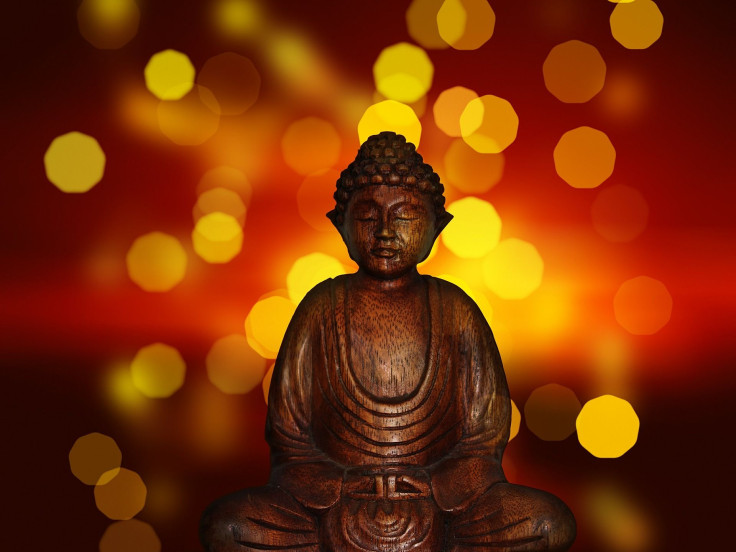Mindfulness Vs Meditation: The Difference Between These Two Pathways To Well-Being And Peace Of Mind

The terms “meditation” and “mindfulness” are tossed around quite a bit these days, highlighted in studies touting their health benefits, or yoga studios declaring new ways for you to find inner peace in your busy life. The terms are often used interchangeably, and sometimes, in their simplified forms, refer to the same general thing — the idea of calming your frenzied mind.
The differences between mindfulness and meditation have been debated and interpreted in thousands of ways, and the debate likely will continue. They’re two sides of the same coin — they complement each other, and they very often overlap. At the same time, each has its own specific definition and purpose.
Much like yoga, the history of meditation and mindfulness is ancient and spiritual, originating in religion. Meditation predates even ancient times, having its origins in prehistoric religions that involved rhythmic chants, or mantras. But the earliest records of meditation can be found in the Vedas, the oldest texts of Hinduism, dating from 1700-1100 BCE. Later on, different forms of meditation began developing in Buddhism and Taoism, mainly in India and China.
Ancient meditation focused on spiritual growth and transcending emotions to live in a calm present state. After being introduced to the West in the 20th century, meditation was realigned to match the goals of a modern, secular society — and it was soon used as a way to reduce stress and improve healthy living, similar to the Western world’s version of yoga.

The Main Differences
Though it’s often a fine line, here’s the main difference between the two: Meditation is a large umbrella term that encompasses the practice of reaching ultimate consciousness and concentration, to acknowledge the mind and, in a way, self-regulate it. It can involve a lot of techniques or practices to reach this heightened level of consciousness — including compassion, love, patience, and of course, mindfulness. So mindfulness is a type of meditation, alongside tantra, yoga, sexuality, silence, breathing, and emptiness.
Mindfulness is the act of focusing on being in the present, such as focusing completely on drinking a hot cup of tea, taking in its scent, warmth, and taste and removing overpowering emotions from the mind.
“Mindfulness is a form of meditation,” Lodro Rinzler, a meditation author and teacher, as well as founder of MNDFL, told Medical Daily. “There are many forms of meditation, including contemplation and visualization, but mindfulness is the type where you bring your full mind to an object.” Being mindful of your breath, for example, is a common form of mindfulness during meditation. Following your breath improves your awareness of being in the present. This is called mindfulness meditation, known as shamatha among Buddhists.
Rinzler adds that eating could be another way to practice mindfulness: “You can be mindful of your food, truly tasting it, and when you drift off into all sorts of thoughts, returning to tasting your food — that is an act of mindfulness.”
The practice of meditation predates the idea of mindfulness, Rinzler explains. Mindfulness is often aligned with the “time of the Buddha,” in which the Buddha discovered that focusing entirely on his breath would allow him to see reality and reach meditation more quickly.

In the modern age, Thich Nhat Hanh, a Vietnamese Buddhist monk who is well-known for his teachings on mindfulness, introduced The Five Mindfulness Trainings to the world. One of Hanh’s students, Jon Kabat-Zinn, would become famous for popularizing mindfulness as a stress reduction and health-based approach in the U.S. In 1979, Kabat-Zinn, Professor of Medicine Emeritus at the University of Massachusetts Medical School, started the Stress Reduction Clinic and the Center for Mindfulness in Medicine, Health Care, and Society to treat chronically ill patients. This jumpstarted the notion and trend of employing mindfulness as a way to live a healthier life.
Health Benefits Of Combining The Two
Whether you want to learn all about the different techniques of meditation — or if you simply want to learn how to be more mindful in your daily life to reduce stress, there’s plenty of evidence to support that harnessing your mind to be in the present can improve your mental and physical health.
One recent study found that people who practice mindfulness had healthier glucose levels, suggesting that improved focus and self-control could help fight obesity and unhealthy eating habits. Mindfulness meditation was also linked to improved sleep quality among older adults who would normally be using pills. It has been associated with improved focus, reduced dependency on opioid drugs, and lowered anxiety and depression levels. But perhaps what’s most remarkable is that research has actually shown that mindfulness and positive thinking had a beneficial effect on the DNA of breast cancer patients, suggesting that the effects of mindfulness meditation on the body may be far more extensive than we know.
Embarking on the journey of meditation can be difficult — but if you want to start out with baby steps, take ten minutes out of each day to remain mindful when drinking tea, taking a break during work, or focusing on your breath before sleep. There’s quite a bit of power in the simple act of focusing your mind.



























